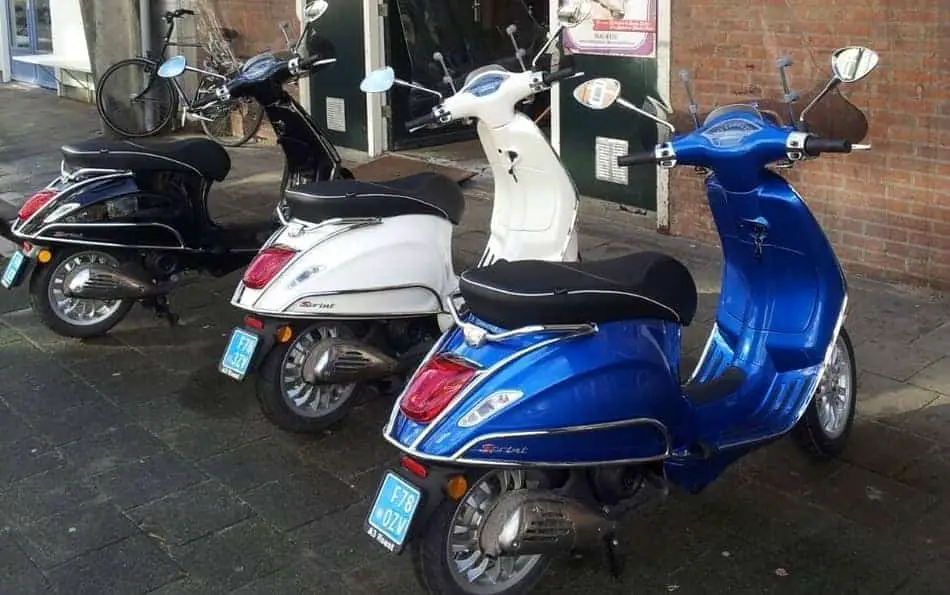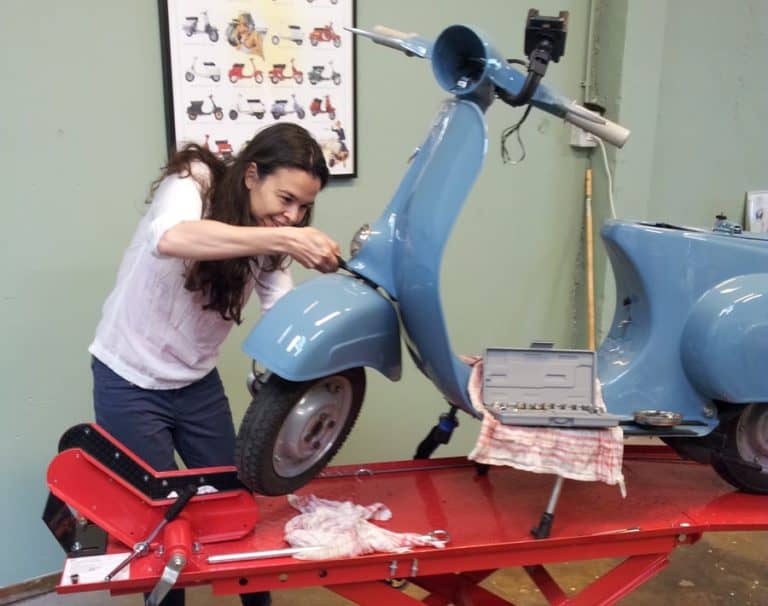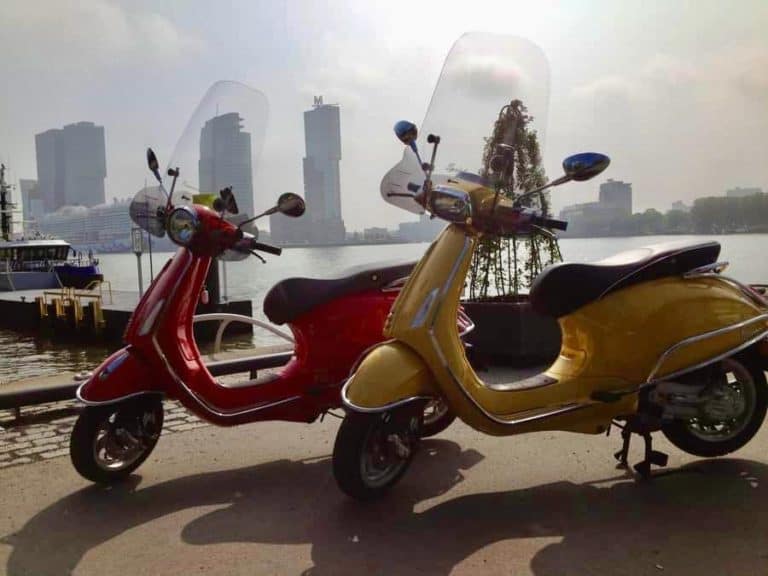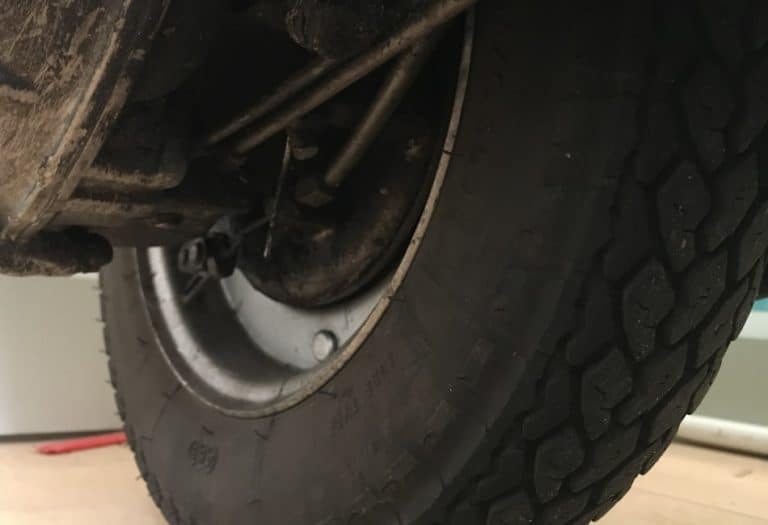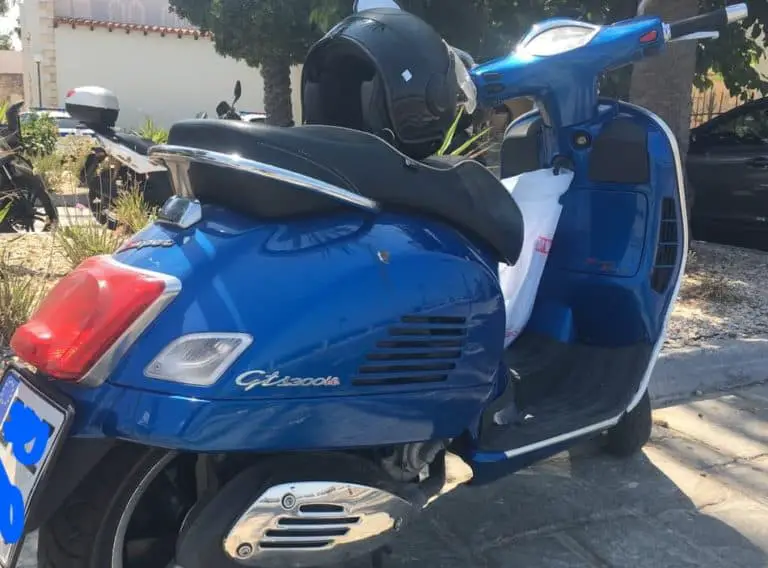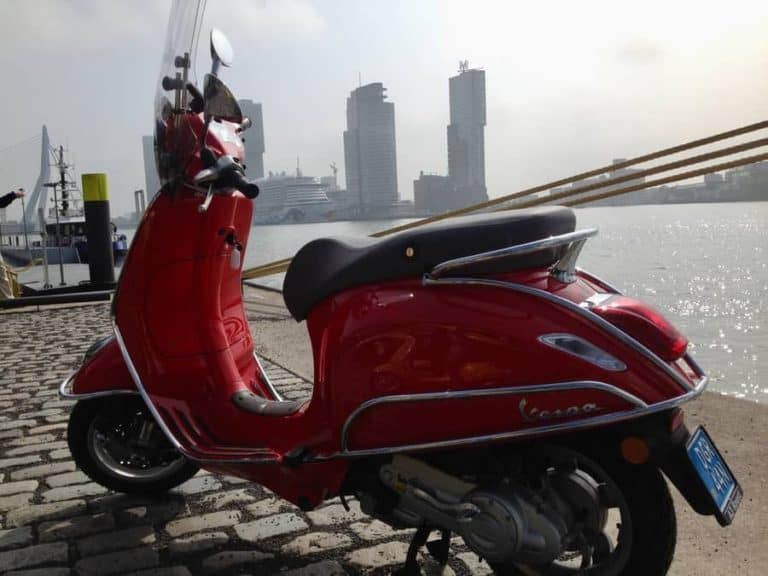Why Does My Vespa Keep Cutting Out? 6 common problems and solutions
The worst thing that can happen with your Vespa is that it keeps dying when you are on the road. It always happens at the worst moment. While regular maintenance is the key to ensuring the best performance of your Vespa, it can always happen that it just keeps cutting out.
It is pretty difficult to say exactly what the problem can be. If you notice that your Vespa isn’t running properly then you just need to start to investigate what is wrong. It can be something very obvious or something that will take time to figure out, including removing some parts.
In this article, we will mostly go into detail about the common problems you can have when your Vespa keeps cutting out. These are things that you might be able to discover and fix yourself. We will leave the complicated stuff for the mechanics in the workshop. If you don’t have any experience, you can do more wrong than good on your Vespa.
These basic checks are often the same for all classic and modern Vespas. However, the 4-stroke Vespa engine is a bit more complicated due to the valves.
When your Vespa keeps cutting out the problem will likely lie in the following:
- fuel flow
- spark
- carburetor
- valves (only 4 stroke engines)
- air filter
- low compression
Most often it is the carburetor that is affected by one of these elements. If the fuel flow is low then the fuel/air ratio in the carburetor will be off. The same if there is a leak in one of the valves. Then the carburetor receives too much air, which again will mess up the fuel/air ratio to the engine leading to low compression. As a result, you will have a Vespa that will be stalling at the traffic light.
So as you can tell, if your Vespa keeps cutting out it can be a small thing that negatively affects the performance of important components.
1. Vespa engine stops due to fuel-related failures
Fuel is the key to running a Vespa smoothly. If something is obstructing or preventing the flow of fuel into the engine, then soon enough your Vespa will not run smoothly and will cut off. First of all, check if you have gas and don’t rely on the indicators alone.
For a classic Vespa double check if your tank is almost empty as you might want to turn the petrol lever to reserve. Sometimes the solution to the problem is as simple as that.
If that isn’t the problem, then check the following:
- leakage
- corrosion
- obstruction
LEAKING
Check under the Vespa if there is any fuel leaking. Then check the engine compartment located under the seat. Make sure that the fuel hose lines (often transparent) from the tank to the pump are properly connected to the carburetor. Run your finger or a dry clean cloth along the hoses and the junctions to check for leaks. Visually check for cracks and wear. Naturally, if you find one, the hose needs to be changed.
If the calibrator doesn’t receive enough fuel, the fuel/gas ratio isn’t correct which will lead to no combustion in the cylinder.
WRONG OR LOW QUALITY FUEL
If you unnoticeably have been filling your Vespa with the wrong fuel then over time it will show. According to Piaggio, a Vespa engine needs at least a gas octane level 91 (for the USA) or Unleaded 95 E5 (for Europe).
Low octane gas tends to break down sooner, which can varnish the fuel system. So if you are not filling up regularly there is a chance this will occur. This will lead to obstruction of fuel and wear of the engine elements.
If you go for the E10 gas instead of the E5, you will be filling up your Vespa with more ethanol. This is alcohol that can lead to corrosion. Other parts made from rubber, plastic, and seals can damage too. We have written more in-depth info on what type of fuel and oil your Vespa needs to run properly.
2. Vespa cuts out due to bad spark plug
The spark plug is essential for the power stroke of your Vespa engine. The spark ignites the fuel/air mixture causing combustion in the cylinder chamber. If the engine doesn’t get the right spark then this will affect the performance of your Vespa.
You will notice that your spark plug isn’t working properly if you have difficulty accelerating, difficulty starting your Vespa, difficulty when idling, and feel that the engine just doesn’t run smoothly.
The color of your spark plug can show you the condition of your engine. A healthy engine has a chocolate brown-colored spark plug.
When checking the spark plug make sure the engine is switched off and is somewhat cold to prevent yourself from getting burnt. Also if you have a new spare spark plug at hand, use it as a comparison. You can easily spot if something is broken or worn.
Location of the spark plug
The spark plug is screwed into the cylinder head at one end and a spark plug cap on the other. The spark plug cap is attached to a cable that runs to the ignition coil.
Modern Vespa 2-stroke: the spark plug is located under the seat. You can access it by removing the cover located below the seat. Use a screwdriver to open it. The spark plug cap is easily accessible.
Modern Vespa 4-stroke: you can reach the spark plug by removing the bucket under the seat. Then look towards the front right side of the frame. Here you can find the spark plug cover. The cover is sometimes also connected to a green or white-colored rubber boot. Use a long plier to pull the spark plug cap straight out.
All modern Vespas come with a spark plug removal and installation kit. It is wrapped in a black plastic bag and found attached located under the seat or in the front compartment.
Classic Vespa: the spark plug is accessible by opening the right cowl or the engine side door panel on a small frame. The spark plug cap is usually above the engine. It is visually easy to see and to pull off. To remove the spark plug you need an official Vespa plug wrench/spanner. This official tool makes it easier to remove and place the spark plug.
A faulty spark plug can be worn, dirty, or just not connected properly. Let’s see what causes this.
SPARK PLUG CAP IS LOOSE
It is possible that the spark plug isn’t connected properly. This can happen due to vibration when riding or when the spark plug cap or rubber boot is worn.
To check if the spark plug is merely loose, see if you can pull it out of the spark plug cap. If it is fitted properly there should be some resistance. Then push it back into the cap. Once you hear a click you will know it is attached properly.
This is also the moment to see if you are dealing with a worn spark plug cap. If there is no resistance when pulling out and placing the spark plug back then this a sign that it is worn and needs to be replaced.
SPARK PLUG IS DIRTY
A spark plug can get dirty and should be serviced during the regular maintenance check. Especially on a 2-stroke engine, such as on a classic Vespa. Clean it with a steel brush and a piece of cloth in order for it to spark properly again.
If you are driving a 2-stroke it is wise to always have a spark plug on you when taking it for a ride. It gets dirty over time but luckily this problem is easy to fix.
SPARK PLUG IS SOAKED IN FUEL
When you remove your spark plug and you see that the spark plug is soaked in fuel then you may be running rich. This means that your fuel/air ratio is off. The engine is getting too much fuel and not enough air. If this is not fixed soon enough it will affect your engine. The oil will be diluted by a large amount of fuel which will minimize the lubrication of the engine.
In this case the problem doesn’t lie in the spark plug. So clean the spark plug, re-attach it.
Running rich will not cut your Vespa engine entirely but it will have difficulty accelerating. To remedy this you need to adjust the fuel delivery of the carburetor and clean your spark plug so it can provide the correct spark again.
SPARK PLUG IS WORN
You can check if your spark plug is actually still working and making a spark. Remove the spark plug from the frame and stick it back into the spark plug cap. The spark is still visible. Then hold the spark against something metal on your bike. Start the engine and if your spark plug is working properly you will see a small spark.
Make sure you are not touching any metal parts with your hands when doing this procedure, as you will get a short circuit. Not lethal, but very painful.
Naturally, if there is no spark then either your spark plug needs replacement or there is something wrong with the cable to the ignition coil.
3. Carburetor malfunction affects your Vespa performance
While you may think that the engine is the most important part for a Vespa to run, the carburetor is equally important. The carburetor ensures that the engine gets the correct amount of fuel and air. It prevents the engine from running rich (too much gas) or running lean (too much air).
The airflow is regulated by the carburetor. The air draws in the fuel and the mixture enters the engine via the intake valve. You can find the carburetor by lifting the seat and removing the plastic container.
If there is a problem related to the carburetor then you might notice:
- slow acceleration
- engine stalls when you open the throttle
- bad idling: stalling or you get the feeling that your Vespa wants to go faster.
You can do some few things before taking the whole carburator out of the Vespa and dismantling it.
AIR LEAKS
An air leak causes air to come into the system where it shouldn’t be. This can mess up the air/fuel mixture of the carburetor which will lead to an engine running lean (the engine doesn’t get enough fuel).
It is wise to check this first before adjusting the carburetor. If one of the lines is damaged then the carburetor shouldn’t be the problem of the low performance of your Vespa. The vacuum hose that goes into the air injection system should be in good condition, check the fuel tap too.
You can check the hoses by starting the engine first. Let it warm up so it isn’t running on the choke circuit. Once the engine is running, listen to how the engine idles. Then use a combustible spray such as a carburetor cleaner or a starter fluid, spray it step by step on the joints of the lines, throttle cable, and eventually along with the cables if necessary.
Spray the intake manifold too. That is the thick hose connecting the carburetor with the engine. The intake manifold provides an even distribution of air into the engine.
If the engine starts to accelerate when you spray on a specific spot, then you have found the location of the leak. Adjust or check the cables for wear.
ADJUSTING THE CARBURETOR
If there are no air leakages then it is time to focus on the carburetor itself. Since the air/fuel mixture is out of tune it needs adjustment. You do so by setting the idle screw and the mixture screw correctly.
The idle mixture screw can be used to adjust the RPM (rate per minute) in the idle speed. In most cases, you can turn the screw by hand on a classic 2 stroke Vespa. You need a small screwdriver to turn it on a 4-stroke engine.
The idle mixture screw controls the air to fuel ratio to the engine on idle speed. A low idle speed (screw counterclockwise) will stall your Vespa. A high idle speed (screw clockwise) on the other hand will make your Vespa jump forward. The noise will also increase making the engine sound like it is in pain.
The air/fuel mixture screw controls how much air mixes with the fuel on the throttle. If this isn’t adjusted correctly, the engine can run rich or lean.
You can do a side check to see if one of these is the case, by checking the color or the spark plug. If you haven’t done this already of course. Too dark means the engine is running rich. Too white means that the engine is running lean.
The air/fuel mixture screw is often located nearby the idle screw. A 2-stroke Vespa just needs a small screwdriver to adjust this, you can easily reach it. On a 4-stroke you would need an air-fuel mixture screw tool to reach and adjust it properly.
So how to adjust the idle mixture screw and the air/fuel mixture screw?
Idle mixture screw:
- Once the engine is warmed up, place the Vespa on the center stand and keep the engine running.
- Turn the idle mixture screw first. Listen to the engine. If it sounds like it’s running faster, turn it the other way until it starts choking a bit. Each time only turn a quarter turn. Do it slowly as it takes about 5 seconds for the engine to show a reaction. You will hear the engine speeding up or faltering.
- You have now set the screw to the maximum setting. From here start turning the idle screw again, each time a 1/4 turn until the engine makes a comfortable and smooth sound. Then listen to how the engine sounds when you turn the throttle. Usually, it takes about 2,5 turns from a fully (not tightly) closed position to a correct idling position.
- When the engine seems flat and less powerful then it is running too rich. If the engine makes a loud high pitched sound and it takes longer for the throttle to return back then it is too lean. Adjust the speed level again by turning the idle mixture screw. Go for a ride and make further adjustments to find the correct position for the idle mixture screw.
If you notice you need to turn the screw almost to fully open for a correct idle speed then there might be a problem with your idle jet. The idle jet is responsible for your scooter to run from idle into a throttle. If this is clogged the carburetor needs to be cleaned or replaced. You do need some know-how to dismantle and clean the carburetor. Dirt can accumulate after a while. Use a carburetor cleaner spray or pressurized air to get the dirt out. Carburetors are luckily not that expensive so if you can’t get it cleaned or fixed then buying a new one is also a good option.
Air/fuel mixture:
In practice, the air-fuel mixture doesn’t need a lot of adjusting. But if you sense that your Vespa is running rich or lean it is useful to adjust the air/fuel mixture to your engine. You can also tell if the carburetor might have internal problems such as a clogged idle jet.
If your Vespa is running rich then you should try the following:
- turn the air/fuel mixture 1/4 counterclockwise. It will take at least half a minute for the engine to adjust to the new setting. So take sufficient time to see what the changes do.
- If the rate per minute increases, continue making 1.4 turn until the rate per minute drops.
- Once it drops, turn the air/fuel mixture slightly back. This should be the ideal setting for the air/fuel mixture.
If the engine is running lean, then you have to do the same procedure but then clockwise. Finally check the idle speed again by adjusting the idle mixture appropriately.
When you are adjusting the air/fuel mixture but the RPM doesn’t change no matter how much you turn, then you need to remove the carburetor for cleaning or replacement.
4. Incorrect Valves adjustment affects the Vespa engine
Valves are only present in 4-stroke Vespas. They play an important role in:
- letting fuel and air into the engine and letting fuel exhaust out
- keeping fuel and air in the cylinder during compression and combustion.
The tappet opens and closes the valve. The space between the tappet and the valve is known as valve clearance. If this is too large the valve will not open completely. Too small? Then the valve will not close completely.
This can lead to:
- incorrect fuel/air flow into the cylinder
- lack of compression
- incorrect exhaust
- overheating after driving for a while.
Your Vespa engine will also likely make a lot of noise and not run properly. If you don’t adjust the valve soon then other moving engine components can break.
During regular maintenance, the valve clearance is always checked. So you should be fine. However, if your Vespa still keeps cutting out after checking all the points mentioned above you might want to double-check the valves.
If you are up to the challenge you can check the valve clearance yourself. You need a feeler gauge tool to measure the correct valve clearance. To be honest, at this point we would take our Vespa to the workshop to have it checked. While it is good to know a thing or two about the Vespa’s engine, we prefer to spend time riding it than repairing it.
5. Dirty Air filter will cause your Vespa to stall
A dirty air filter will result in your Vespa stalling, reducing power or sluggish throttle.
The air filter prevents dirt from entering the engine. If the filter is dirty or obstructed then it will prevent sufficient airflow to the carburetor resulting in a wrong fuel/air ratio.
If you stick to the maintenance schedules then you shouldn’t find yourself with an air filter problem. However, if you drive your Vespa a lot on dusty roads then you might consider cleaning it more often.
You can of course do it yourself. The filter is located just above the oil crankcase. But check your Vespa manual to see exactly where it is. The location can differ per type.
Once you remove the filter you can clean it with water and shampoo. Then dry it with a clean cloth. Once it is dry, immerse it in a mixture of 50% oil and 50% petrol. Squeeze the filter and let it drip for a while. Then place it back.
6. Vespa will cut out due to low cylinder compression
If your Vespa still keeps cutting out after checking the fuel, spark plug and carburetor then the problem can be the valve (as mentioned) or the compression of your cylinder.
You need to remove the cylinder to check if the piston, rings, and cylinder walls are ok. Like the valves, we recommend going to an authorized workshop to do this. They are not only able to clean and replace the cylinder, but they can also determine what caused the low compression.
The initial cause is just as important. Otherwise you will have problems with your Vespa soon enough again.
What else can you do?
The points mentioned above are just a couple of initial problems your Vespa might be having resulting in cutting out at the most inconvenient moments. However as you may have noticed, one malfunction can quickly lead to another.
If you are not experienced with engines then it is wise not to start fixing all kinds of things. However, some obvious problems as described above can be fixed without doing much harm.
But we always recommend someone qualified to check what is causing your Vespa to stall. It might be expensive to have it fixed but in the end, it will save you money.
We have lost a lot of money by trying to save costs. All kinds of mechanics who could fix it cheap usually didn’t fix anything in the end. From our experience, those who are qualified usually have your Vespa running smoothly in no time.

